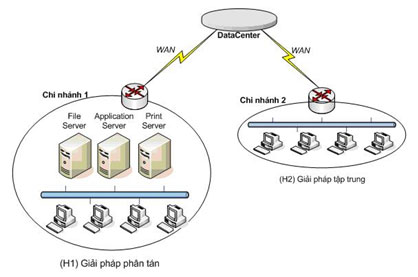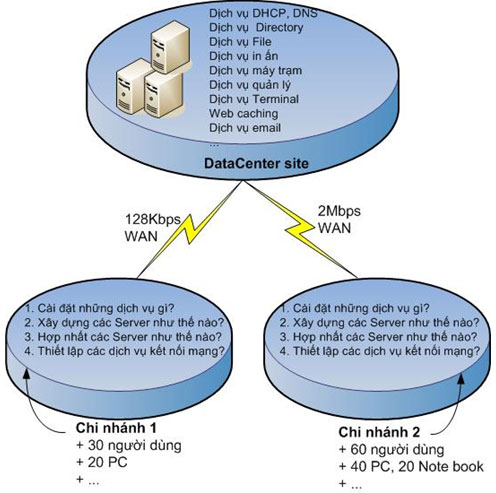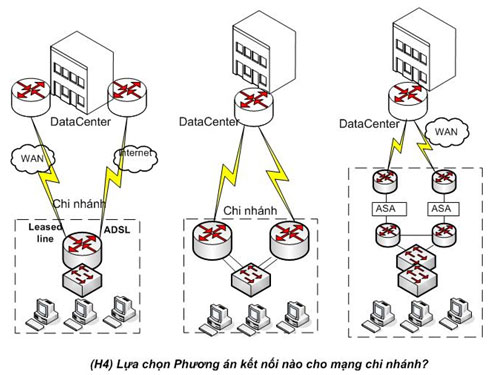Network design for branches (Part 1)
1. The development of branches of businesses
Branches of companies are growing both in quantity and scale to meet new markets and to increase competitiveness.
According to statistics :
- 80% of the company's employees work at branches. For retail, this figure is 95%.
- The number of branches grew by 11% in 2007
- Retail or financial companies have about 500 branches
So there is a tendency to shift resources from Head Office (DataCenter) to branches (Branch office))
- IT costs at branches make up 33% of the overall IT cost of businesses
- On average, there are about 4 to 6 servers in each branch
- 20% of servers are located in branches
( According to research by Internet Research Group - January 2008 )
Currently, there are 2 options for deploying IT infrastructure for branches: Distributed Solutions - Investment in hardware and software at branches (H1) and Concentrated solutions - focusing on hardware and software Application at DataCenter and providing services for branches (H2).

For distributed solutions : the services are provided at the branch so there is high availability, however the cost is high. Besides hardware costs (Server, backup system, storage, router), application software, WAN transmission costs connect to Datacenter, . each branch needs to have IT department to manage system operation. system.
Concentrated solution : there is much lower cost because it does not have to purchase network equipment, application software but services are provided from Datacenter via network connection (WAN). Besides the advantages of cost, this solution also has the advantage of the ability to standardize technology, centralized management capabilities in DataCenter. The disadvantage of this solution is that the number of services is limited, the performance of the applications is low due to poor quality WAN links (low speed, transmission errors .).
The question is : how to design and install the branch network system to create a 'hybrid' solution that both satisfies the business requirements of the business and saves costs?
This article deals with solving the above question by service-oriented design. This is a close approach to reality about the need to use information infrastructure of businesses. The article has references to services provided by Microsoft Windows server 2003 system and Service-Oriented Network Architecture (SOA) of Cisco.
2. Service-oriented design method
The question in section 1 is answered by looking at the following four issues:
1. The focus of the service: What services will be installed in DataCenter and which services will be installed at the Branch?
2. Standardize servers: How to build servers (roles, functions, numbers .) to ensure the IT service requirements of enterprises?
3. Consolidate services on the same server: what services can be installed on the same server to save hardware costs?
4. How to set up the LAN and WAN connection services at the branch to solve the problem of line quality as well as the redundancy when something goes wrong?
Services provided by Server system include : Basic service group and extended service group:

a. Basic service group
- Directory service: provides authentication service for client machines
- DHCP service: provides dynamic addressing (IPV4 / IPV6) for client machines
- DNS service: domain name resolution for client machines
- File service: provides techniques to manage data storage, data synchronization, file sharing and secure search speed.
- Printing services
- Workstation services: antivirus, remote desktop access
- Management services: data updates, service monitoring, data backup and recovery
b. Extended service group:
- Terminal service.
- Web caching: provides Internet-related features, such as speeding up Web browsing, protection proxies.
- Email service
- Service is collaborative, sharing information
- Virtualization service.
- Firewall service
Network connection services : A very important issue to consider is the WAN transmission link from the branch to the Datacenter. A low-speed, poor-quality, high-probability WAN transmission line is the main barrier to deploying services from Datacenter to branch.
Figure 4 shows three approaches when designing network connectivity services for branches. Network connection services include:
- WAN service: provide connection from Branch to DataCenter
- LAN service: providing connectivity for equipment at the branch
- Addressing and routing services: EIGRP, OSPF, BGP, Static, RIP, NAT .
- QoS services: Queuing, Dropping, Shaping, .
- Security and network security services: attack prevention, ensure reliable data transmission, avoid data theft.
- Mobile services: providing connectivity to users everywhere through wireless LAN, cellular, . technologies

3. Conclusion
Currently, understanding a practical model of systems and networks that businesses currently use is a concern of many enthusiasts in the system administration, network. They are always wondering: what is the job of the network administrator? How to build such a network? How does that system work? And one important thing for those who are participating in network management classes is: how the knowledge and practice of the classroom lesson is applied in the network model mentioned above.
The problem is to choose a network model so that it can describe the content of the entire course, completely realistic and apply technology trends? At iNET IT Academy (Microsoft Network and Systems Administration training specialist, Cisco), the network design model for the branch has met that. Thus, the students' requirements for studying an actual network system model, from initial construction to commissioning, will be met.
This article is the introduction, proposing a service-oriented approach to solving the problem of information infrastructure for branches of enterprises so as to ensure business requirements and save costs. charge. Details of each service design will be covered in the following articles.
-------------------------------------------------- -----------------
Nguyen Khanh Tung - tungnk@inet.vn
NIIT- INET Information Technology Training Academy
Number 9 Ho Tung Mau - Mai Dich - Cau Giay - Hanoi
 How to send email using the command line in Linux
How to send email using the command line in Linux Fix 7 common computer symptoms
Fix 7 common computer symptoms Firefox 3.1 Beta 2 launches private browsing mode
Firefox 3.1 Beta 2 launches private browsing mode Protect your computer with Secunia PSI
Protect your computer with Secunia PSI Discover Gmail Task
Discover Gmail Task Windows 7 can run on mobile devices
Windows 7 can run on mobile devices